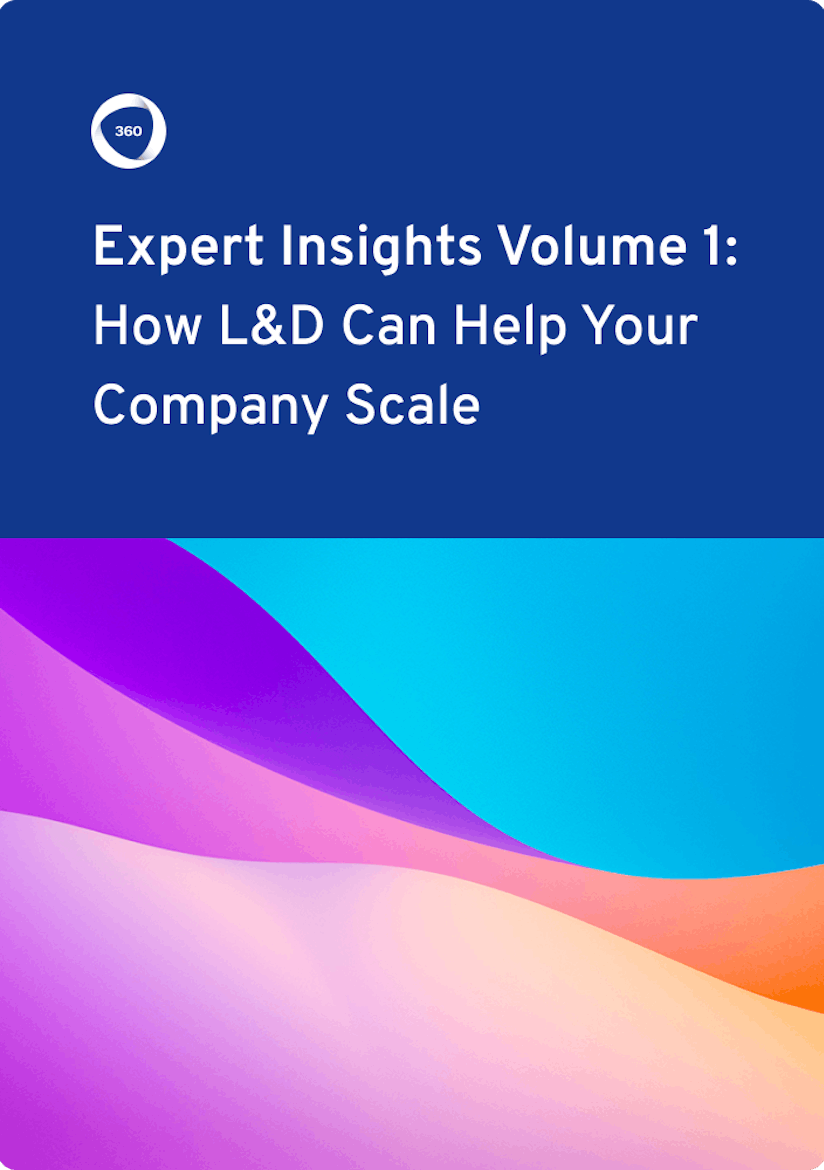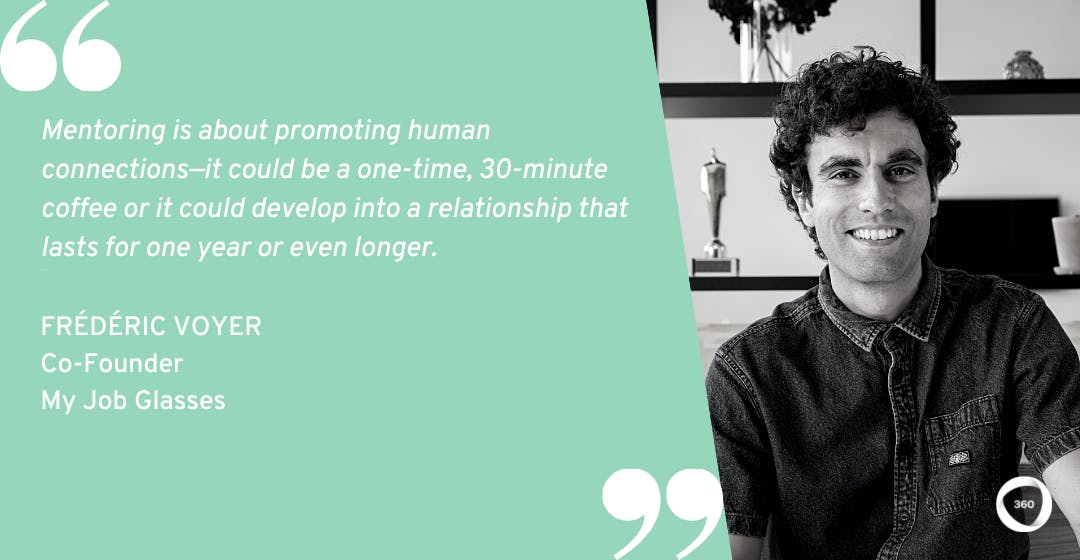For many L&D leaders, the changes to working environments and the effects of the Great Resignation have bumped professional development and career guidance to the top of the priority list.
But where do you go to get expert advice on the career guidance challenges people face? And how can you design learning programs that eliminate these pain points and improve job satisfaction at the same time?
Well, you’ve wandered into the perfect space to find the answers to those crucial questions. In my latest interview, I spoke with Frédéric Voyer, Co-Founder at My Job Glasses, about how they design career mentoring by leveraging human connections and how they measure their clients' success using their platform.
Read on to hear why building real human connections is so crucial to an online platform company like My Job Glasses.
Loving what you’re reading? Come and join the L&D Collective for more great learning insights, resources, and events!
Real human relationships are crucial to mentor connections
At My Job Glasses, Frédéric explains, they bring human relationships to the heart of career guidance.
“We created the company six years ago. Today, our solution is used by 300,000 users in 130 countries. Basically, our product is a platform allowing people to share their experiences in real life,” he says.
“We created My Job Glasses because we believe that in real life, human relationships are the best driver for professional performance. Unfortunately, our digital work today tends to remove these real-life relationships.”
So, Frédéric and the team created two products. The first is the original product which is an open platform of over 3,000 companies. “The value here is employer branding and recruitment. Following people to connect and convert a pipeline of talented people willing to know more about the company and its jobs,” says Frédéric.
We believe that in real life, human relationships are the best driver for professional performance. Unfortunately, our digital work today tends to remove these real-life relationships.
The second product, as Frédéric notes, is a private platform for client companies that allow people inside the company to connect to each other and share experiences at scale—there are many business case examples such as onboarding, geographical moves, and mentoring.
Need a few more expert insights? Find out how L&D leaders at Amazon, WhatsApp, Klaviyo and more are driving growth with the right L&D strategy.

You have questions–the experts have the answers
By providing your contact info, you agree to receive communications from 360Learning. You can opt-out at any time. For details, refer to our Privacy Policy.
Two challenges My Job Glasses are solving right now
Currently, My Job Glasses are solving two L&D challenges: allowing students to have access to shared knowledge when joining and choosing their first job and allowing information sharing to flow within their clients’ organizations.
First up, Frédéric explains how they are working to connect students with professionals within their selected industry.
1. Connect students with professionals within the industry
At first, says Frédéric, the focus of My Job Glasses was to allow young people to have access to a wide professional network.
“The first challenge we identified for these young people is finding and choosing their first job. Basically, it's an orientation issue, but 50% of young people quit their first job before the end of the first year. What we identified is that the main problem is that students do not have access to enough qualitative information about jobs,” he says.
When applying for their first job, students are faced with information density problems because while there is a lot of information out there like job descriptions or videos, this is really poor information, explains Frédéric. The solution as designed by My Job Glasses is to connect students with a professional before they enter the job market.
50% of young people quit their first job before the end of the first year. What we identified is that the main problem is that students do not have access to enough qualitative information about jobs.
For example, you would not choose to purchase an apartment without visiting it first. “But people like to do that when choosing a job,” he says. “They just choose a job in which they will spend eight hours a day for many years without chatting with someone doing the job already.”
“They simply meet HR people through the job recruitment process, but this is not a natural conversation. They can’t ask questions like: What challenges might I face? What does a career path look like at this company? What’s important in the company?”
Frédéric explains that students should meet professionals before entering a company. “The access to the qualitative information and qualitative information is inside people's heads and in their experiences,” he explains.
So, that’s how My Job Glasses is connecting students to professionals in their selected industry and making an impact. But how can you deploy mentoring to help grow new hires?
2. Let information and experience sharing flow within the organization
The second challenge, Frédéric says, is that once you enter the company, your journey isn’t over because you will want to keep learning.
“The second issue is having access to the information,” he explains. “So, this is basically what you do at 360Learning and I love that is how you bring value from everybody at scale. The way we do that at My Job Glasses is by using a SaaS tool to allow people to chat together in an informal way (face to face, visio, call), and we are doing that at scale.”
Frédéric thinks that once you’re in the company, that company should allow information and experiences to flow internally. “Too many times you don't know what the guy next door is doing and what his experience is. Whereas this experience would likely be valuable for you now or in the future at that company,” says Frédéric.
Related: How Johnson Controls Jump-Started its Digital Transformation with a 3-Step Peer Learning Strategy
What the right career mentoring looks like
As Frédéric explains, there is a common thought that mentoring is just one thing when in fact, mentoring covers a wide range of possibilities.
“For us,” he says, “we believe mentoring means promoting human connections. And it could be a one-time, 30-minute coffee or it could develop into a relationship that lasts for one year or even longer.”
When you agree that mentoring is essentially having a human experience, Frédéric finds a great place to start is thinking about what value that experience brings to clients. These include business cases like onboarding.
“On a previous episode from Stuart,” says Frédéric, “it was really interesting to hear Gemma Incoronato explaining that they use mentoring to flow onboarding.”

Mentoring can also allow people to know more about their jobs and other opportunities. You can have onboarding, new jobs, or new geographical positions. “For instance, reverse mentoring,” says Frédéric. “You can have business cases where older, more experienced people want to learn from younger people arriving in the company.”
“But the problem is,” he says, “if you are a big company, how do you scale the process? And this is more or less what Gemma said about Stuart. I noticed they were doing that for 100 people. She explained that she had to match people based on their experience.”
“We tested that with some clients and really it's a nightmare. When you face 50 to 100 people, you spend hours, or weeks, doing the matching and people are not happy at the end. So, scaling is key and this is the value we bring with My Job Glasses. We make mentoring and professional experience sharing at scale within companies.”
My Job Glasses’s approach to the right career mentoring highlights the advantages of collaborative learning. By connecting experienced professionals within organizations to students considering specific industries, My Job Glasses is impacting retention and recruitment for their clients.
So, how does Frédéric know that their mentoring products are having an impact? As he explains, it is all about two key impacts.
Measuring the impact of mentorship: Retention and recruitment
In Frédéric’s experience, you can seek two success measurements from your mentoring programs.
Retention
Promoting mentoring at scale, Frédéric explains, allows people to share their experiences at scale— it will have an impact on employee retention.
“CEOs and HR professionals recognize the value of mentoring and knowledge sharing within the organization. The output we expect is attrition: retention in the company.”
“The figure we target is a 25% boost in retention of those people leaving the mentoring experience. By creating the flow of information you can help people find other opportunities and the right information which will help them decide to stay with the company, rather than quit.”
So for in-house mentoring, you aim for better retention, which is of massive value for your organization.
Recruitment
As Frédéric explains, the second success measurement is recruitment.
“This was our main value proposition at the beginning of My Job Glasses,” he says. “Meaning, you bring many companies together so your collaborators can be ambassadors and mentor people from outside the company.”
As Frédéric explains, allocating these ambassadors and connecting them to the outside world allows you to create a pipeline of talents, with the output being improved employer branding and recruitment.
“For instance,” he says, “we have some partners who convert 8% of their talent pipeline. They’ve been able to achieve this by being proactive, enabling HR teams to nurture and communicate with the pipeline of talents before the staffing need arises. This replaces the traditional way of recruiting—acting reactively by posting on job boards when a staffing position becomes urgent. The difference in conversion is huge.”
Thanks to Frédéric for sharing his insights on career guidance and mentoring with us!
For more advice on how to set up mentorship programs, check out our interviews with Gemma Incoronato at Stuart about her three-part strategy for delivering flexible hybrid learning, or with Johnathan Saller at Disney Media & Entertainment Distribution about his four-step approach to creating a mutually beneficial mentoring program.
Want more peer insights on transforming workplace learning? Sign up to become a member of the L&D Collective, and check out our other #CLOConnect interviews with top L&D leaders on driving growth and scaling culture through Collaborative Learning. Or you can subscribe (below 👇) to our weekly newsletter to receive our latest posts directly in your inbox.


